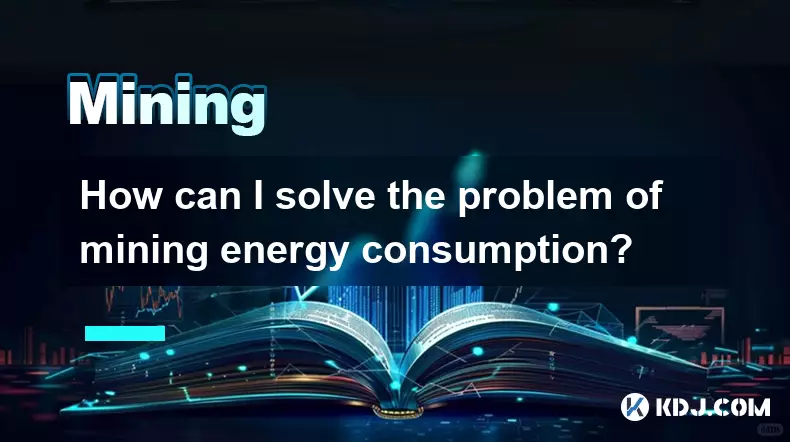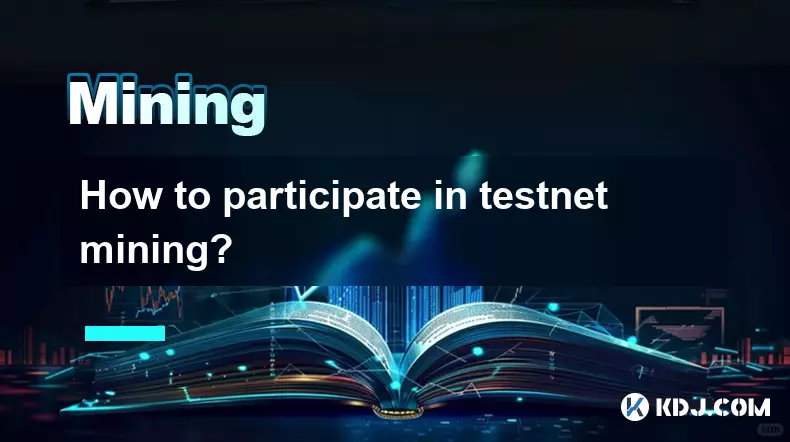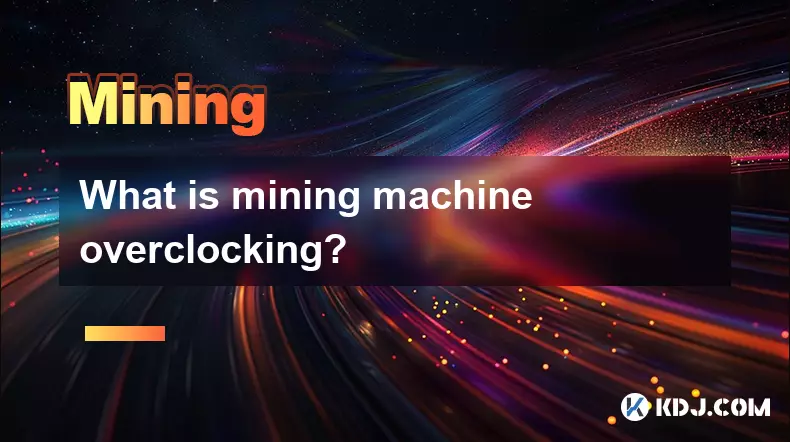-
 bitcoin
bitcoin $109523.663807 USD
-0.13% -
 ethereum
ethereum $4019.526508 USD
2.06% -
 tether
tether $1.000482 USD
0.00% -
 xrp
xrp $2.776815 USD
0.18% -
 bnb
bnb $958.942396 USD
0.12% -
 solana
solana $204.294698 USD
3.84% -
 usd-coin
usd-coin $0.999693 USD
0.00% -
 dogecoin
dogecoin $0.232115 USD
2.09% -
 tron
tron $0.338028 USD
0.84% -
 cardano
cardano $0.790920 USD
1.50% -
 hyperliquid
hyperliquid $44.871443 USD
5.60% -
 ethena-usde
ethena-usde $1.000322 USD
0.04% -
 chainlink
chainlink $21.034165 USD
2.60% -
 avalanche
avalanche $28.794831 USD
-0.54% -
 stellar
stellar $0.360466 USD
1.24%
How can I solve the problem of mining energy consumption?
Cryptocurrency mining's high energy use, especially in proof-of-work systems, raises environmental concerns, but shifts to renewables, efficient hardware, and proof-of-stake offer sustainable solutions.
Sep 22, 2025 at 03:00 am

Mining Energy Consumption: A Pressing Challenge in the Crypto Industry
The rapid expansion of cryptocurrency mining has brought energy consumption into sharp focus. As blockchain networks grow, so does the demand for computational power, leading to significant electricity usage. This issue is especially prominent in proof-of-work (PoW) systems, where miners compete to solve complex mathematical puzzles. The environmental footprint of such operations has drawn criticism from regulators and environmental groups alike.
1. Cryptocurrency mining, particularly Bitcoin, relies heavily on energy-intensive hardware like ASICs. These machines operate continuously, consuming vast amounts of electricity, often sourced from non-renewable fuels. The carbon emissions associated with coal-powered mining facilities have raised serious sustainability concerns.
2. Geographic concentration of mining farms in regions with cheap but fossil-fuel-based energy exacerbates the problem. Countries like Kazakhstan and parts of China previously hosted large-scale operations powered by coal, contributing to localized pollution and global emissions.
3. The economic incentive structure of PoW rewards speed and processing power, encouraging miners to deploy more machines rather than optimize efficiency. This creates a self-reinforcing cycle of escalating energy use as network difficulty increases over time.
4. Public perception plays a critical role. High-profile figures and institutions have criticized Bitcoin’s energy use, comparing it to the consumption levels of entire nations. This scrutiny pressures the industry to adopt cleaner alternatives or face potential regulatory restrictions.
5. Despite these challenges, the crypto sector has begun exploring viable solutions that balance decentralization, security, and environmental responsibility. Innovation in both technology and policy is driving change across multiple fronts.
Transitioning to Renewable Energy Sources
One of the most direct approaches to reducing mining's environmental impact is shifting operations to renewable energy. Solar, wind, hydro, and geothermal sources offer sustainable alternatives to fossil fuels.
1. Mining facilities located near hydroelectric dams or wind farms can leverage abundant clean energy. For example, certain operations in Iceland utilize geothermal and hydropower, achieving nearly zero-carbon footprints.
2. Some companies are investing in their own solar installations or entering power purchase agreements (PPAs) with green energy providers. This not only reduces emissions but also stabilizes long-term operational costs.
3. Stranded or curtailed renewable energy—such as excess wind power generated at night—can be redirected to mining activities. This repurposing prevents waste and enhances grid efficiency.
4. Regulatory incentives and carbon credits may encourage greener practices. Jurisdictions promoting clean tech could offer tax breaks or subsidies to eco-conscious mining ventures.
Adopting renewables transforms mining from an environmental liability into a driver of clean energy adoption.Advancing Hardware Efficiency and Design
Improving the energy efficiency of mining equipment is another crucial strategy. More efficient hardware delivers higher hash rates per watt, directly lowering energy demands.
1. Chip manufacturers are developing next-generation semiconductors optimized for cryptographic calculations. These include specialized ASICs with reduced thermal output and improved power management.
2. Liquid cooling systems and advanced airflow designs help maintain optimal operating temperatures, minimizing wasted energy from overheating.
3. Modular data centers allow for scalable deployment while maximizing energy distribution efficiency. These setups enable dynamic load balancing and remote monitoring.
4. Recycling heat generated by mining rigs for district heating or agricultural applications adds secondary value, improving overall energy utilization ratios.
Efficient hardware not only cuts electricity bills but also extends equipment lifespan and reduces e-waste.Shifting Consensus Mechanisms
The move from proof-of-work to proof-of-stake (PoS) represents a fundamental transformation in how blockchains validate transactions. Ethereum’s transition to PoS drastically reduced its energy consumption by over 99%.
1. In PoS systems, validators are chosen based on the amount of cryptocurrency they stake, eliminating the need for energy-heavy computations.
2. Networks like Cardano, Solana, and Tezos operate on PoS or hybrid models, demonstrating that high throughput and security can coexist with low energy use.
3. Decentralized finance (DeFi) platforms built on these chains benefit from faster transaction finality and lower fees, all while maintaining ecological responsibility.
4. Newer protocols incorporate layer-2 scaling solutions and sharding to further reduce node workload, enhancing scalability without increasing energy demands.
Consensus innovation proves that blockchain integrity does not require massive energy expenditure.Frequently Asked Questions
What is the estimated energy consumption of Bitcoin mining?Bitcoin mining consumes approximately 120 terawatt-hours (TWh) annually, comparable to the electricity usage of countries like Norway or Argentina. However, this figure fluctuates with market conditions and network difficulty adjustments.
Can mining become completely carbon neutral?Yes, through a combination of 100% renewable energy sourcing, carbon offset programs, and heat recovery technologies. Several mining firms have already achieved carbon-neutral certification by integrating these strategies.
How does proof-of-stake eliminate energy waste?Proof-of-stake replaces computational competition with economic accountability. Validators lock up coins as collateral, removing the need for continuous hashing. This shift reduces energy use by eliminating redundant processing.
Are governments regulating crypto mining energy use?Several nations have introduced policies targeting energy consumption. For instance, the European Union has debated restrictions on PoW, while countries like Canada and Georgia implement licensing requirements tied to energy sourcing transparency.
Disclaimer:info@kdj.com
The information provided is not trading advice. kdj.com does not assume any responsibility for any investments made based on the information provided in this article. Cryptocurrencies are highly volatile and it is highly recommended that you invest with caution after thorough research!
If you believe that the content used on this website infringes your copyright, please contact us immediately (info@kdj.com) and we will delete it promptly.
- BlockchainFX: The Crypto Presale Primed for a 2025 ROI Explosion
- 2025-09-27 18:25:19
- ETH Price Check: Smart Money Stays Cool Amidst ATH Rollercoaster
- 2025-09-27 18:25:19
- Aster Price, MrBeast, and DEX Volumes: What's the Buzz?
- 2025-09-27 18:45:11
- Shiba Inu, Meme Coins, and MAGACOIN FINANCE: What's Next?
- 2025-09-27 18:45:11
- Aster DEX: Navigating DeFi's Future with Price Predictions and Key Insights
- 2025-09-27 18:50:01
- Virtuals Protocol's New Genesis: A Deep Dive into the Launch and $VIRTUAL's Potential
- 2025-09-27 18:50:01
Related knowledge

The difference between staking and mining
Sep 24,2025 at 05:18am
Understanding Staking in the Cryptocurrency Ecosystem1. Staking involves holding funds in a cryptocurrency wallet to support the operations of a block...

How to participate in testnet mining?
Sep 22,2025 at 09:18am
Understanding Testnet Mining in the Crypto Ecosystem1. Testnet mining is a method used by blockchain developers to simulate real-world conditions on a...

How to dispose of abandoned mining machines?
Sep 19,2025 at 08:19pm
Assessing the Condition of Abandoned Mining Rigs1. Begin by inspecting each mining machine for visible damage, corrosion, or missing components. Machi...

How to identify high-quality mining pools?
Sep 21,2025 at 03:19pm
Reputation and Track Record1. A mining pool’s reputation is built over time through consistent performance and transparency. Pools that have operated ...

Advantages of decentralized mining pools
Sep 20,2025 at 04:36pm
Enhanced Security and Resistance to Censorship1. Decentralized mining pools operate on blockchain-based smart contracts, eliminating the need for a ce...

What is mining machine overclocking?
Sep 21,2025 at 07:19pm
Understanding Mining Machine Overclocking1. Mining machine overclocking refers to the process of increasing the operating frequency of a cryptocurrenc...

The difference between staking and mining
Sep 24,2025 at 05:18am
Understanding Staking in the Cryptocurrency Ecosystem1. Staking involves holding funds in a cryptocurrency wallet to support the operations of a block...

How to participate in testnet mining?
Sep 22,2025 at 09:18am
Understanding Testnet Mining in the Crypto Ecosystem1. Testnet mining is a method used by blockchain developers to simulate real-world conditions on a...

How to dispose of abandoned mining machines?
Sep 19,2025 at 08:19pm
Assessing the Condition of Abandoned Mining Rigs1. Begin by inspecting each mining machine for visible damage, corrosion, or missing components. Machi...

How to identify high-quality mining pools?
Sep 21,2025 at 03:19pm
Reputation and Track Record1. A mining pool’s reputation is built over time through consistent performance and transparency. Pools that have operated ...

Advantages of decentralized mining pools
Sep 20,2025 at 04:36pm
Enhanced Security and Resistance to Censorship1. Decentralized mining pools operate on blockchain-based smart contracts, eliminating the need for a ce...

What is mining machine overclocking?
Sep 21,2025 at 07:19pm
Understanding Mining Machine Overclocking1. Mining machine overclocking refers to the process of increasing the operating frequency of a cryptocurrenc...
See all articles









































































